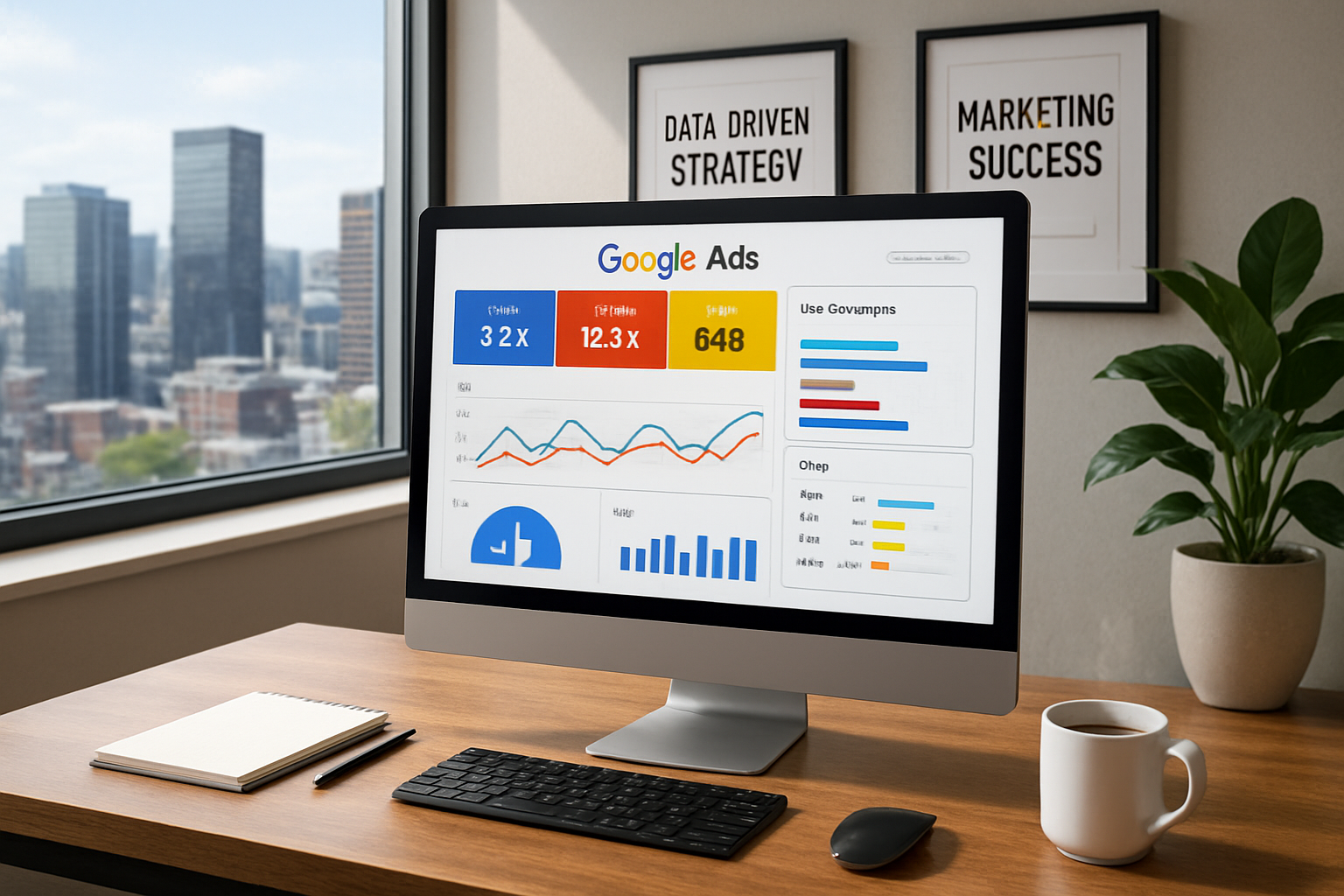You've probably stared at your Google Ads dashboard wondering where all the money is going. It can feel like pouring cash into a black hole with no real return. A proper Google Ad spend strategy is less about a massive ads budget and more about smart math.
Many business owners think success is about outspending the competition. But that's a quick way to burn through your funds and see poor google ads performance. A truly effective Google Ad spend strategy comes down to knowing your numbers inside and out.
You'll learn how to connect your google ads budget directly to your profit goals. We'll move from guesswork to a data-driven plan for all of your google ads campaigns. This way, every one of your ad dollars has a purpose.
Use Our Hubspot Inbound Marketing and Sales ROI Calculator to Find out the ROI you can Get From Using Hubspot Inbound Marketing and Sales Software.
Why Bother with Google?
Let's get one thing straight: Google isn't just a player in the search market; it practically owns the stadium. When you combine all their properties like Search, YouTube, and the Android system, they hold a dominant market share. Ignoring the opportunities on google ads google provides is like trying to sell boats in a desert.
Because of its dominance, it's often the first and most critical channel for customer acquisition. Different campaign types serve distinct purposes in your digital marketing funnel. For instance, search campaigns capture active demand, while display ads are excellent for building brand awareness across the web.
You can also run video campaigns on YouTube to engage audiences visually or Shopping campaigns if you're an e-commerce business. The real question isn't if you should use ads google offers, but how much you should invest across these different formats. The answer to that starts with your own business math and clear goals for each google ads campaign.
The Golden Rule: Spend What You Can Afford
Deciding on a Google Ad spend strategy starts with a simple question. How much can you spend to get a new lead and still turn a profit? This isn't about picking a random number; it's about understanding your break-even point before you manage ad spend.
Think about the profit you make from a single sale. A portion of that profit is the absolute maximum you can spend to acquire that customer. Anything more, and you're losing money on the deal, no matter how much revenue your ads campaign brings in.
This means you have to look past the top-line revenue and dig into your business costs. Only then can you find the magic number that keeps your ad campaigns profitable and informs your budget setting. Your total budget should be grounded in these financial realities.
A Tale of Two Budgets: Small vs. Large Deals
Not all sales are created equal, and your ads spend strategy needs to reflect that. A company selling high-volume, low-cost products will approach their monthly budget very differently from one closing massive enterprise deals. Let's look at two real-world examples to understand the necessary budget management.
The High-Volume, Low-Price Game
I once worked with a client spending about three million dollars a year on ads. Their initial sale was small, around $230. But, they had a strong recurring revenue model and a great customer retention rate over five years.
We figured out it cost them about $35 per lead, making this a great lead generation campaign. Their break-even point on a new customer was $140. So, they needed to close a sale within four leads (3.98 to be exact) to make money in the first year.
This client wanted 2,000 sales a month from their paid channels. Knowing they needed around four leads per sale at $35 per lead, we could build their annual and monthly spend plan. This simple math guided their entire multi-million dollar strategy, keeping it profitable and predictable by using a Target CPA bid strategy.
The High-Stakes World of Big Deals
Now, let's switch gears to high-ticket ads campaigns. For over two decades, I've been deep in the world of SAP enterprise software sales. Here, the numbers are dramatically different, and so is the approach to google ads budgeting.
A typical SAP software license might start at $100,000, but a single large deal can easily top a million dollars just for the license. When you're talking about a million-dollar sale, spending a few hundred dollars on leads is a no-brainer. But the path to that sale is much longer.
These deals involve huge buying committees, sometimes with 10 to 13 decision-makers. You have to nurture and convert each of those people, which can take months. Your overall sales conversion rate might be tiny, but the payoff from a single conversion justifies the careful budget spend.
Practical Budget Management in Google Ads
Understanding your numbers is one thing; applying them inside the Google Ads platform is another. You'll set a campaign budget, but how you manage it determines your success. This involves understanding daily budgets, monthly limits, and using the right tools.
When you set up a Google Ads campaign, Google recommends setting a campaign daily budget. However, it's crucial to understand that your daily spend might fluctuate. On days with higher search traffic, Google may spend up to twice your campaign daily budget to capture more opportunities.
Don't panic, this is part of the system for preventing overspending across the month. Google will not charge you more than your daily budget multiplied by the average number of days in a month (30.4). This calculated figure acts as your monthly spend limit, providing a level of predictability for your total budget.
Here's a simple breakdown of how these budget controls work together.
| Budget Control | How It Works | Key Consideration |
|---|---|---|
| Daily Budget | The average amount you're willing to spend per day on a campaign. | Actual daily spend can be up to 2x this amount. |
| Monthly Spend Limit | Your daily budget x 30.4. This is the maximum you'll pay in a month. | This is a cap, not a target; your actual monthly spend may be lower. |
| Total Budget (Lifetime) | An optional cap you can set for a campaign's entire run. | Useful for short-term campaigns with a fixed budget. |
Using Tools to Plan Budgets and Control Spend
Managing your Google ads spend isn't a "set it and forget it" task. Google provides tools like the Performance Planner to help you forecast the expected performance of your campaigns. This tool analyzes historical data to suggest how budget changes might impact your key metrics, helping you plan budgets more effectively.
For more direct control, you can use automated rules. These are rules based on conditions you define, which can help manage ad spend without constant manual checks. For example, you can set rules to have campaigns pause automatically if you've hit a certain cost threshold or if the campaign's performance dips below a specific metric.
You can create automated rules based on a variety of triggers. A common rule is to pause a campaign when its monthly cost exceeds your planned budget. This ensures a campaign that isn't performing well doesn't keep wasting money before you have a chance to review it.
Your Secret Weapon for a Winning Google Ad Spend Strategy
For any business with a sales cycle longer than a few days, there's a critical tool you need to use. It's called Offline Conversion Tracking, or OCT. This is how you tell Google which clicks actually turned into paying customers, even if it happens weeks or months later.
What is a GCLID and Why Should You Care?
When someone clicks on your Google ad, a unique tag is added to the URL. This tag is the Google Click ID, or GCLID. Its purpose is to track that specific click all the way through your sales process, from initial interest to final sale.
By capturing the GCLID in your CRM like HubSpot, you can later send that data back to Google when a deal closes. This feedback loop is pure gold. It trains Google's machine learning, which powers automated bidding strategies, to find more people just like your best customers, which makes your ad spend far more effective.
The 90-Day Ticking Clock
There's a catch, however. A GCLID comes with an expiration date: 90 days. If your sales cycle is longer than three months, you can't report that conversion back to Google using this method. The connection is lost, and that valuable data point disappears.
Why do they expire? People clear their browser cookies or change devices, and tracking becomes impossible. This is a big challenge for industries with long sales processes, but even if you can only attribute a portion of your sales, the data is still immensely valuable for optimizing your bidding strategies.
A Google Rep's Brutally Honest Advice
I once had a very helpful Google Account Rep tell me something that I've never forgotten. He said he wouldn't spend a single dollar on Google Ads unless he could close the sales loop. Without connecting the click to the final sale, you're just guessing and likely wasting money.
His point was that pay-per-click conversion tracking is everything. If you can't feed sales data back into the system, you're flying blind and your budgets google ads run on are inefficient. Google's algorithms are powerful, but they need good data to optimize for your target return on ad spend.
This means having a system in place is not a luxury; it's a necessity. Without a closed-loop system, you will always spend more than you should on your ads campaign. You will miss out on the platform's best features that help you get a positive target return.
Beyond the Numbers: Your Offer is Everything
You can have the most dialed-in ads budget and the best tracking in the world. But if your offer stinks, none of it matters. A winning Google Ad spend strategy relies on having a compelling and competitive offer, whether for search, display, or video ads.
This goes deeper than just the ad itself. Your keywords, your ad copy, and the landing page experience must all be perfectly aligned. The user should get exactly what they expected when they clicked your ad, and this applies even to an ads video campaign.
Google measures this alignment with a metric called Quality Score. A high score means Google thinks you're giving users a great experience, and they reward you with lower costs and better ad positions. Improving your Quality Score is one of the best ways to optimize your monthly spend, as you get more for your money.
Conclusion
Building a successful Google Ad spend strategy doesn't require a secret formula. It requires discipline and a commitment to data from your campaigns. Start by figuring out your real cost per sale and what you can afford to spend while remaining profitable, and then select google ads as your platform.
Then, set up the systems to track everything with GCLID sales tracking and make sure your campaigns continue running smoothly. Connect your ad clicks to real revenue and feed this data back into the system. This lets you optimize your google ads spend, not just for clicks or vague leads.
And remember, your offer is the foundation of it all. Without a strong, clear offer, you're building your strategy on sand. Combine great tracking with a great offer, and you'll turn that ad dashboard from a source of frustration into a powerful growth engine for your business.
We are a full-service Hubspot Certified Inbound Marketing and Sales Agency. In addition, we work to integrate your SAP System with Hubspot and Salesforce, where we have a deep delivery capability based on years of experience. Please our book a meeting service to get started.




